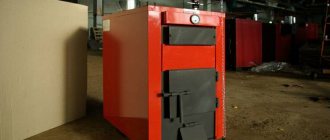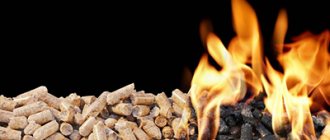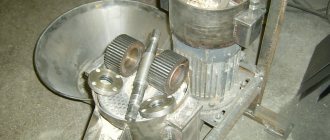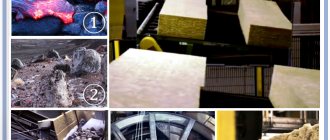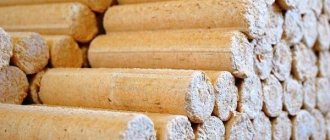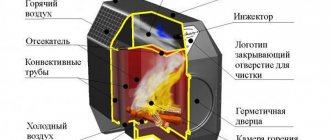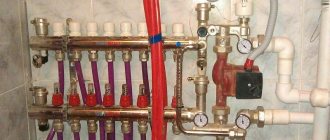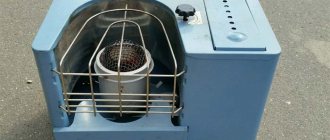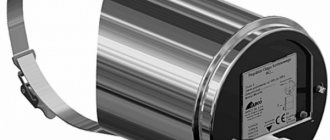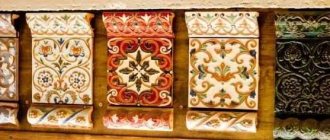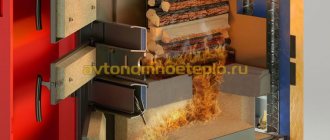When planning a heating system in a private home, the first and most important issue that needs to be resolved is the choice of power source. If the main gas line runs far from the house, and it is not possible to run it due to complexity and cost, and an electric boiler can also significantly impact the budget, the option of alternative fuel remains. One of these are pellets.
This type of fuel in Russia is recognized as environmentally friendly, and it successfully replaces traditional firewood that needs to be prepared or coal, the delivery of the latter can also cost a pretty penny. Only natural gas can provide healthy competition to them, but as was said, it’s all about cost.
Pellets have several names: pellets, pellets and simply pressed granules made from waste wood-based material. They have a small cylindrical shape. Abroad, this type of fuel has long been successfully used in domestic and industrial boiler houses.
And it must be said that they are in demand due to the following qualities:
- Environmentally friendly, thanks to the raw material used in production.
- Economical due to the high degree of combustion.
- Thermal conductivity.
In general, this is a modern type of fuel that can, if necessary, replace any of the materials existing today.
Application
Being, in fact, a means of igniting and maintaining combustion in home and industrial stoves, they have found application in several other areas, which need to be discussed in more detail.
Home stoves and fireplaces
There is nothing new in this - this is their main purpose. They are used in solid fuel boilers. Excellent combustion support no worse than classic coal or firewood. But in recent years, pellets have become in great demand among happy owners of home fireplaces. Agree that it is inconvenient to store a bundle of firewood in the room so that you can throw in a few firewood if necessary.
How much time and effort does the preparation take? And if you use your country house only on weekends, then you need to ensure their storage. In this case, a bag of pellets that fits comfortably in any pantry will come in handy.
But here are some recommendations for use. Having decided to use them as fuel for the fireplace, you will need to replace the standard grate with one with smaller holes so that the pellets do not fall through them. It is also recommended to adjust the air supplied to support the fire by reducing it slightly. In this case, they will burn longer and warm the room faster.
Use in hiking conditions
They also became frequently used in this area. Light and convenient fuel for picnics. In order not to look for dry sticks in the forest to light a fire, you can use pellets before preparing dinner. One bookmark will burn for an hour and a half, which is enough to cook soup or barbecue.
Cleanliness of pets
When pellets first appeared on the market, no one thought that they would find wide application in this area. Enterprising people, sensing an opportunity to make money, began packing them into bags called “Toilet filler.” It began to be used as an adsorbent in cat litter boxes, cages of rodents and other animals. It must be said that the man’s friends accepted this innovation with a bang. And you can find a lot of positive responses on this topic on the Internet.
Why did he interest pet owners?
- Porosity allows you to absorb not only moisture, but also reliably “lock” odors.
- There is no dirt or dust when using, everything is simple and easy to clean by flushing them down the toilet.
- The environmental component and production materials give the pellets an unobtrusive pine smell.
- Safety for both humans and pets. It does not cause allergies and does not stick to the paws, so it does not spread around the house.
- It does not decompose, and the tray is easy to clean before changing.
It can be added that pellets have competed well with the main types of toilet fillers, displacing them from a high position in the consumption rating.
Good absorbent
Many dealership centers and simply large auto repair shops purchase it for their needs. But not as fuel, but for preventive purposes. Without having much difference with sawdust, pellets allow you to cope perfectly with oil stains, removing them down to the slightest drop.
Classification of pellets and their characteristics
At first, one variety could be found on sale, and there were no distinctions.
But as they say, time does not stand still, and even such a simple material has acquired several types, classified by type of application:
White pellet
Highest grade (premium). The production uses clean wood chip waste without bark and resinous secretions, which allows you to leave a minimum of ash after combustion. The calorific value of this product is 17.2 MJ/kg. In production and sale on the market, they make up 95% of all products and are used in any heating stoves and for household needs.
Industrial pellets
A lower quality product, as evidenced by its purpose. They are used only in boiler room furnaces, and cannot be used at home. The presence of fireproof residues and tree bark in the composition affects the ash content. And if we talk about heat capacity, it is almost the same as white pellets.
Agropellets
This is a standard type of fuel made from industrial waste and sunflower seeds, buckwheat and other combustion products. They are used in large boiler houses that heat small villages or private houses, which is facilitated by a high calorific value of 15 MJ/kg. The ash content of 3% and residues can clog the air ducts, so when using them, periodic cleaning is recommended, or better yet, the use of a special boiler exclusively for heating with agropellets.
Characteristics
Pellets are presented in the form of small pressed round-shaped cylinders, with varying diameters of a maximum of 25 mm. 6-10 mm granules are in particular demand. This form ensures the flowability of the fuel, allowing them to be used with any automated feeding devices existing today in boiler rooms.
Socio-economic benefits
2.1 New jobs
Thanks to the production of pellets and the use of wood, new jobs are created in the industrial, forestry, agricultural and service sectors. This significantly affects the cost of fuel and also strengthens the social structure of the region.
2.2 Security of supply
Wood is a raw material that grows constantly and, accordingly, is not exhausted. If we assume that times will come when fossil fuels are used up, then wood will help us out.
2.3 Price advantages
Pellets are a cost-effective alternative to fossil fuels. Their prices are formed regardless of the prices of oil and gas, the resources of which may be exhausted over time.
Advantages and disadvantages
Speaking about quality characteristics, you need to start from the positive side, since the material has more such qualities than negative ones:
- Environmentally friendly. Enough has already been said about this; we can add that during the combustion process, carbon dioxide is released from them in an amount equal to the natural decomposition of wood. This allows us to reduce the greenhouse effect, which is a global problem today.
- Its low ash content makes it a virtually waste-free material, and the remaining cinders can be used as fertilizer.
- Pellets are not subject to self-ignition , so the risk of fire during transportation and storage is minimal.
- They are easy to stack and store , and their high bulk density allows them to be transported in large quantities.
- High calorific value is characterized by the fact that one ton of this fuel produces up to 3.5 thousand kWh of heat.
- Waste-free production is justified by the fact that residues from woodworking production are used for their production.
They also have disadvantages that do not stand out too much against the background of their positive qualities:
- To use them, you need a specialized pellet boiler. It is not prohibited to work with conventional sources; this simply increases the combustion efficiency.
- Despite its widespread use abroad, in Russia it is an expensive type of fuel , and purchasing a specialized boiler will cost more than purchasing a regular wood-burning one.
- By organizing heating with pellets, you will of course be able to save on heating costs in the future, but to store them, you need a dry warehouse.
Selection by raw material
The key to the quality of pellets can be considered the raw materials from which they are made, peat or wood. Here, an important role is played by such a characteristic as ash content, that is, the amount of product obtained during fuel combustion. It is worth noting that manufacturers combine concepts such as ash and slag.
Slag refers to solid impurities, such as sand and earth.
Pellets made from peat have a high ash content due to mineral inclusions. It is about three percent, which is twice as high as standard grade wood pellets. This means that peat pellets are very poorly suited for home-type boilers and can even damage them. However, industrial boiler houses work well on this type of fuel. The reason for this is its low cost with approximately the same heat transfer. The ash, rich in impurities, is used as fertilizer.
If we talk about wood pellets, then we most often talk about which is better - coniferous or birch. Paradoxically, conifers are often better in quality. One would expect high hardness, low humidity and slower burning from birch pellets, but do not forget that during the granulation process all the qualities inherent in solid wood are lost.
The production technology includes grinding the raw material and drying it, so that hardness and moisture remain at approximately the same level, which in turn compares their heat transfer. The advantage of softwood for the manufacturer is that the final yield of pellets from softwood is larger in volume. In turn, for the consumer, pellets made from pine needles are of better quality, since they contain more of the adhesive polymer lingin, which improves their quality. In this case, pine has the largest amount.
Pellet production
Turnkey pellet production line
The technological process consists of several stages at which the source material, undergoing various processing, is fed into molding machines:
- First, chips or other waste are crushed , depending on the type of pellets produced. The material is crushed to such an extent that there will be no particles in the structure exceeding 1.25 cubic meters in volume. see. Such raw materials will dry out faster and will be allowed for further actions.
- At the second stage, the semi-finished product is dried. Technological parameters do not allow the use of crumbs with a moisture content exceeding the norm above 8-12%. Dryers are drum and belt machines used according to the type of raw material being produced.
- After drying, the source material undergoes another stage of crushing to obtain smaller granules that are better amenable to pressing.
- The material enters the press after sorting: 4 mm, granules for the production of industrial pellets, and no more than 1.5-2 mm for first-class raw materials.
- Water treatment. This stage of technological production allows you to bring the chips to “standard”. In essence, this is another drying step in which the original product is given a nominal percentage of moisture that is ideal for bonding.
- Pressing is carried out in various devices, with a flat or cylindrical matrix. At the end of the process, the workpieces are cooled, after heating in the machines to 70°-90°C.
- The last stage is sifting , sorting and packaging of the finished product. This is necessary to separate broken pellets from good ones.
Waste-free production lies in the fact that substandard granules are subjected to repeated processing.
Description of raw materials
Pellets are pellets made from wood waste.
Pellets are wood pellets processed with a special material. Essentially they are wood processing waste. Pellets are environmentally friendly natural raw materials, which do not contain hazardous chemicals and compounds. They are non-toxic and safe for health and the environment.
The best raw materials for making pellets are sawdust, cuttings, shavings, slabs, wood flour and other waste. Depending on the type of wood, the granules can be white, black, or gray. Farmers can create pellets from hay, sunflower husks, reeds, rice husks and other agricultural waste. Their processing is not difficult and does not require special equipment. You can also produce pellets from peat. This is a more expensive process, as it requires special equipment and good resources.
The main parameters include:
- Ash content. The lower it is, the better for the boiler - it does not require frequent cleaning.
- Humidity. The amount of water in pellets is about 60.
- Total length of granules.
- Density.
- Bulk mass.
- Abrasion class.
Properties also depend on the rock from which the fuel is made.
Standards and quality
In the Russian market, it is customary to use European quality standards, which are obtained by foreign manufacturers. Our pellet production business is usually compared to these already accepted standards. The lack of permits can scare away wholesale buyers, while a certified product costs an order of magnitude higher.
European standards, “EN plus and EN” require the following data in product documents:
- length and diameter of granules;
- bulk weight;
- maximum calorific values;
- product moisture;
- percentage of slag per specific gravity;
- hardness;
- ash content;
- maximum combustion temperature;
- content of volatile impurities and production slags;
If a manufacturer wants to establish the production of pellets, he must confirm the availability of equipment and premises certified according to the EN plus class.
Combustion stages
Any fuel produces a certain percentage of heat when burned.
The same thing happens with pellets when they enter the combustion chamber. Conventionally, the heat transfer process can be divided into three stages:
- Stage one is evaporation of the liquid. This is a fleeting process. Due to the low moisture content (8-10%), for example, in dry firewood it is 30%, high combustion efficiency is ensured.
- Stage two is pyrolysis. At which about 80% of the thermal energy is released from the pellets. The most important point here is that it is necessary to ensure a maximum flow of oxygen into the combustion chamber.
- Stage three – burning charcoal. In the product residues, after the release of pyrolysis gas, about 20% of thermal energy remains. In order to generate maximum heat from pellets, the oxygen supply at this time must also be maintained at the required level.
At all stages, it is important to maintain an optimal level of combustion, regulated by the oxygen content in the furnace. We also do not recommend an excess, in this case, most of the energy will “fly down the drain”; the disadvantage is undesirable in that the pellets will not completely burn out, providing a minimum heat influx.
ENplus certification
In fact, the money is very good and we need to work in this direction today. But there are a number of obstacles that you will have to face. And one of them, almost the most important thing, is the certification of pellets according to ENplus.
It is because of this certificate that more than half of all applicants are eliminated. Eliminated due to poor-quality granules. But first things first.
The ENplus certificate was recently introduced. The fact is that Europeans have a lot of pellet boiler systems, and most of this equipment is used for heating a house or small room in automatic mode.
Such small boilers are very sensitive to low-quality granules, and if the latter have a high ash content or more sand than required, the boiler may fail.
That's why smart Europeans decided to introduce this standard. ENplus divides all pellets into three categories: A1, A2 and EN-B.
- A1 and A2 - granules for home use;
- EN-B these pellets are used for combustion in large thermal power plants or power plants. Their cost is low, as are the requirements for them.
On average, certification can cost a company 12 thousand euros. But sometimes relapses occur and you may not receive a certificate the first time. Then it is necessary to call the certifying authority again and re-pay for its services. To prevent this from happening, I wrote a useful book where everything is described in detail. And here is actually herself. In addition, I can directly help in choosing a certification organization and organize the visit of a specialist to your production. To do this, I need to leave a corresponding request in the “SUPPORT” section.
Comparison with other fuels
The use of this fuel is beneficial from various points of view. And environmentally friendly.
For comparison, you can conduct an oral analysis:
- Like other types of fuel, the use of wood pellets can be done in a fully automated manner.
- Their high calorific value makes them stand out against the background of ordinary chips and lump wood.
- They burn almost completely, unlike wood and coal, leaving no ash that can clog the air ducts and boiler burner.
- High filling capacity and convenient packaging allow them to be transported in any container.
- Storage requires less space than the same firewood.
- They are not explosive and will not ignite during any handling; this sets them apart from fuel oil and liquid fuel.
Economic components:
- Price stability, not tied to a jump in the dollar.
- Also, the economic component is highlighted by the fact that over long-term use, pellets will not clog the boiler system and you will not need to spend money on purchasing new burners or carry out expensive cleaning of the system, as when using fuel oil.
Environmental benefits:
- Unlike other types of fuel, they can be stored in close proximity to housing, without any odors or harm to health.
- The granules do not contain allergic spores, only a natural product.
- Completely harmless to the environment.
Speaking about the amount of heat you produce, in relation to other types of fuel, the following figures are obtained: a ton of granular fuel releases 5000 kW of energy during combustion.
The same amount is released by other materials in the following quantities:
- diesel fuel – 500 liters;
- fuel oil – 685 liters;
- wood – 1600 kg;
- gas – 475 cubic meters;
Benefits of pellets
Wood pellets are a modern fuel that recently became popular among Russian consumers. To understand why it is superior to traditional energy sources, let's understand the characteristics, composition and other points.
Consumers highlight the following advantages of pellets:
-Excellent calorific value, which is due to the minimal presence of moisture in the pellets, compared to the driest firewood.
-Low ash content, which allows you to minimize cleaning procedures for boiler equipment, in comparison with firewood, coal or peat.
-The fuel is completely environmentally friendly, which means that during combustion there are minimal emissions into the atmosphere and ash residues, which can be used as fertilizer in the soil.
-Convenient to load into the boiler installation - options from “manual feeding” to “automatic dosing” into the corresponding boilers.
-High level of fire and explosion safety of the boiler using wood pellets.
-The low cost is due to the fact that raw materials for pellets are formed in huge quantities after wood processing and in most cases they are left to rot in the forest, causing harm to the environment.
-Practical and easy to store. The high density of granules saves space in the warehouse.
Also read news on this topic
- Wood pellet production
- Pellets for heating price
- Industrial pellets
- The advantage in everything - pellets
The main advantage of pellets is that they burn cleanly. Why are they safe?
Fuel can be made from any type of unused wood or even some plants, but most often wood chips, shavings, and sawdust from hardwood or softwood trees are used. No chemicals are added to the composition.
The shine on the granules leads many people to assume that there is some kind of glue that holds the crushed fractions together. This is a myth, because instead the raw material is heated and pressurized to give the natural lignin in the wood the properties of an adhesive.
Pellets should not contain used wood, such as parts from old furniture. This is because the wood used is most often coated with varnish or paint. These chemicals, if burned, will turn into vapor and become airborne, making the pellets unsafe.
The cleanliness of the wood and the efficiency of pellet stoves mean that very little smoke is produced from the wood pellets burned. The smoke is essentially a mist of gases and unburned particles of matter, but almost all of the pellet is burned, so there is little material left to become smoke, especially compared to a traditional wood stove.
Pellet stoves also create less creosote, which builds up inside the chimney and inside the fireplace. Unfortunately, even pure wood pellets contain some components that will not burn, such as minerals, calcium and potassium, which occur naturally in trees. These minerals are destined to turn to ash when burned, but the advantage of pellets is that there will be much less ash than when burning wood or coal.
You can purchase pellets at a low cost directly from the manufacturer. You can get a free sample to test to ensure the quality. For any questions, call: + 7 (831) 339-14-60
Storage
The material is transported and stored in special plastic bags. It is not prohibited to use other containers for these purposes: boxes, tanks, etc. The main thing is that the place is dry and clean. You can pack it in small portions and store it in your home pantry, adding it to the fireplace as needed.
Outdoor storage is not recommended, especially in cold weather. Even if the place is dry, temperature changes will form condensation, which can reduce the quality of combustion and the level of heat produced.
User reviews
You can find various forums on the Internet that present both positive and negative aspects of using pellets.
Here are a few for comparison:
- Sergey. The draconian payment bills constantly cost me huge amounts. After they brought us a bill for the first heating month of October with an amount of 15 thousand, my wife decided not to tempt fate and switch to pellet heating. We purchased a KST-25 boiler with a 14/40 kW burner. Of course, now you spend less on heating, but there are problems with purchasing. We have to constantly purchase large quantities, for which we had to organize a separate warehouse in the basement.
- Alexander. I own my own beauty salon. Deciding to get off the “gas needle” (you had to pay 10 thousand to heat a small room), I chose pellet heating. Having tried several types, I settled on an alternative option, sunflower husk granules, I pay 1.5 thousand rubles for one ton. Some simple calculations gave me an amount of 14 thousand, which was enough for heating from October to April. Quite acceptable.
Considering that we are increasingly trying to imitate Europe, this heating option will soon become one of the popular ones. In our market, the production of pellets and the sale of boilers have not yet been fully established, so there is a good option for organizing your own business, as well as big advantages in favor of switching to this alternative heating method.
Type and size of pellets
In terms of external appearance, pellets are pressed, cylindrical material with a diameter of up to 25 mm. Pellets with a diameter of 6-10 mm are widely used.
This form favors the flowability factor and allows the use of all known automation methods in the feeding devices of boiler houses. Taking into account this factor, it should be said that pellets have become the main compressed fuel in Europe.
Straw pellets are also used as bedding for livestock, and grass or hay pellets are considered valuable feed. According to the pellet production technology, due to steam processing, the amount of digestible proteins increases.
The density of pellets formed under high pressure reaches 1.25 t/m3. Pellet humidity is 10...12%. By comparison, green wood has a moisture level of half its weight. Thus, pellets are a concentrated source of energy. By definition, the calorific value of pellets is 5-7 times higher than the calorific value of raw materials of the same volume, and is equal to the calorific value of coal.
